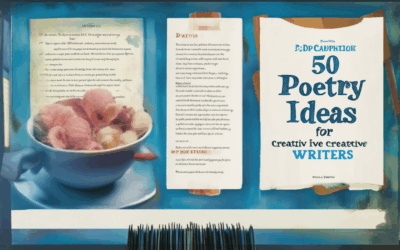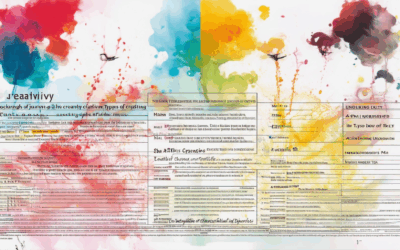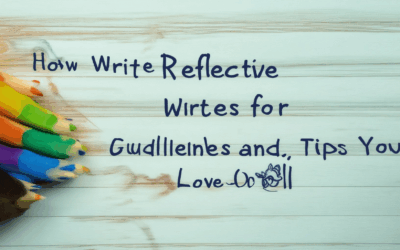Unlocking Creative Writing Thoughts: Tips, Prompts, and Examples
Have you ever sat down to write, only to find your mind drawing a blank? Whether you’re a seasoned writer or just beginning, unlocking creative writing thoughts can feel like a daunting task. But imagine the joy of crafting a compelling story, poem, or essay—when your thoughts flow naturally, ideas seem to appear from nowhere, and your words take shape effortlessly. This guide is designed to help you tap into that creative well, offering tips, prompts, and examples to spark your imagination and keep your pen moving.
From brainstorming techniques to practical writing prompts, this article explores the art of capturing those elusive creative writing thoughts. Discover how to overcome writer’s block, experiment with unique formats, and find inspiration in everyday experiences. Whether you’re looking to refine your skills or simply explore new avenues, these creative writing ideas and prompts will guide you toward unlocking your full potential as a writer.
Key Takeaways:
- Internal Monologue: Use phrases like “she thought” or “he pondered” to naturally depict characters’ internal conversations, making their thoughts relatable and engaging.
- Actions as Indicators: Subtly reveal thoughts through actions such as fidgeting or avoiding eye contact, which can hint at nervousness or uncertainty without direct expression.
- Visual Descriptions: Enhance character depth by describing environments or expressions that imply their mental states, such as a cluttered room suggesting chaos.
- Metaphors and Similes: Employ metaphors like a tangled maze or storms to visually represent complex emotions, ensuring they align seamlessly with the character and story.
- Consistent Tone and Style: Match the language and structure of thoughts with a character’s personality to maintain narrative coherence and avoid inconsistency.
- Balanced Use of Techniques: Employ internal monologues sparingly to maintain pacing and focus, using other methods like actions or visuals to complement rather than overwhelm.
- Cultural Sensitivity: Incorporate cultural elements thoughtfully to add depth, avoiding stereotypes and ensuring respectful representation.
By integrating these strategies, authors can effectively convey characters’ thoughts, enhancing both engagement and narrative depth.

30 Creative Writing Ideas to Inspire Your Next Project
Here are 30 creative writing prompts to spark your imagination and help you overcome writer’s block:
- 1. The Talking Plant : Imagine a world where plants can communicate. Write a story about a young gardener who discovers a talking flower and uncovers its secret mission to save the forest.
- 2. The Time Travel Letter : You find a letter addressed to yourself from your future self. What does it say? How does it change your perspective on life?
- 3. The Animal’s Day Off : Write from the perspective of a dog who takes a day off from fetching balls to explore the neighborhood and discover hidden secrets.
- 4. The Magic Candle : A candle in an old shop grants you one wish. What would you wish for, and how does it change your life?
- 5. The Library of Wishes : There’s a library that only appears once a year. What happens when you enter and discover a book that predicts your future?
- 6. The Robot Who Felt Pain : A robot developed to feel no pain starts questioning its purpose after experiencing a moment of empathy.
- 7. The Map of Truths : A mysterious map reveals the shortest path between two points but always leads to unexpected truths about the traveler.
- 8. The Forgotten Village : You stumble upon a village that seems to have been forgotten by time. What secrets does it hold, and why has it been abandoned?
- 9. The Clockmaker’s Dilemma : A clockmaker discovers a flaw in his design that could alter the course of time itself. What choice does he make?
- 10. The Letter from the War : You find a letter written during wartime to a loved one. What does it reveal about the writer’s struggles and hopes?
- 11. The Mirror of Memories : A mirror allows you to relive any moment in history. Which memory would you choose to relive, and why?
- 12. The Shipwreck Secret : You uncover a hidden treasure shipwrecked centuries ago. What secrets does it hold, and who is waiting to claim it?
- 13. The Guardian of Dreams : A creature protects a valley where all dreams are born. What happens when a threat emerges?
- 14. The Robot’s First Love : A robot falls in love with a human, challenging traditional notions of romance and humanity.
- 15. The Island of Lost Stories : A group of writers arrives on an island known for its cursed stories. Can they survive long enough to finish their works?
- 16. The Tree That Talks Back : A tree in an ancient forest speaks to you. What does it tell you about the past or future?
- 17. The Machine of Second Chances : A machine can erase one regret from your life. What would you erase, and how would it change your present?
- 18. The Lake of Reflections : A lake reflects your past, present, and future. What do you see, and how does it affect your decisions?
- 19. The City of Lost Keys : A city where nothing works unless you find the right key. What happens when you unlock its secrets?
- 20. The Notebooks of the Dead : A series of notebooks found in a haunted house reveal the last thoughts of its inhabitants. What do they teach you?
- 21. The Garden of Unseen Colors : A garden where flowers glow in colors invisible to most humans. Why are they there, and who visits them?
- 22. The Box of Wonders : A box containing strange objects that grant wishes. What happens when you open it?
- 23. The Bridge of Echoes : A bridge that echoes every sound you make. What does it reveal about your past or present?
- 24. The Tower of Forgotten Memories : A tall tower where each floor holds memories of people who disappeared. What do you discover?
- 25. The Book of Unwritten Stories : A book of stories that haven’t been written yet. What happens when you read them?
- 26. The Doorway of a Thousand Voices : A doorway that hears your thoughts and tells you stories from the voices of the past.
- 27. The Mountain of Shifting Sums : A mountain where numbers change based on your thoughts. What challenges does it present?
- 28. The River of Endless Possibilities : A river where you can change your past, present, or future. What would you do?
- 29. The Temple of Silent Songs : A temple where the walls sing if you listen carefully enough. What do the songs reveal?
- 30. The Field of Lost Objects : A field where lost objects come to life and tell their stories. What object would you talk to, and what would it say?
How to Format Thoughts in Creative Writing
Formatting thoughts in creative writing involves using techniques that help convey internal monologues, reflections, or mental processes effectively. Here are some methods to achieve this:
- Using Italics: Enclose thoughts in italics to distinguish them from dialogue or narration. For example:
She wondered if he would come.
- Adding Tags: Use phrases like “she thought,” “he realized,” or “they considered” to explicitly mark thoughts. This makes the distinction clear:
He thought about the consequences.
She wondered where he had gone. - First-Person Narration: Write thoughts directly from the character’s perspective, as if the reader is experiencing their thoughts firsthand:
I heard the door creak and froze.
- Quotation Marks: Use quotation marks to highlight specific thoughts, especially when they are part of a larger narrative:
“I must have misheard,” she said to herself.
- Blending Thoughts: Integrate thoughts seamlessly into the story, showing the character’s emotions through actions or subtle cues:
Her eyes darted nervously across the room, her mind racing for an escape plan.
Tips for Effective Thought Formatting:
- Choose the method that best fits your narrative voice and style.
- Be consistent to maintain clarity for the reader.
- Balance description with brevity to keep the pace of the story.
- Experiment with different methods to find what works best for your writing.

Good Words for Creative Writing
- Powerful Verbs: Words like “thunder,” “soar,” “dance,” “explode,” and “whisper” add energy and movement to your writing.
- Descriptive Adjectives: Use words like “velvet,” “mystical,” “golden,” and “icy” to paint vivid pictures in the reader’s mind.
- Emotional Triggers: Words such as “loss,” “hope,” “fear,” and “love” tap into universal emotions that resonate deeply with readers.
- Imaginative Metaphors: Replace literal descriptions with figures of speech like “stormy seas” or “ladder to the sky” to elevate your writing.
- Unique Synonyms: Break free from clichés by choosing less common alternatives like “serene” instead of “peaceful” or “shimmering” instead of “glistening.”
- Specific Sounds: Incorporate sensory details with words like “chime,” “roar,” “sizzle,” and “hush” to immerse the reader.
- Storytelling Elements: Use words like “conflict,” “resolution,” “character,” and “plot twist” to structure compelling narratives.
- Vivid Imagery: Paint scenes with words like “sunrise,” “ocean waves,” “mountain peaks,” and “desert sands” to create lasting impressions.
- Abstract Concepts: Express complex ideas through words like “freedom,” “identity,” “destiny,” and “truth” to provoke thought and reflection.
- Dynamic Contrasts: Balance light and dark, peace and chaos, or beauty and horror with words like “radiant,” “ruins,” “calm,” and “turmoil.”
- Timeless Phrases: Use words like “eternal,” “forever,” “ancient,” and “timeless” to convey enduring themes and emotions.

How Do You Describe Thinking in Creative Writing?
Thinking in creative writing can be expressed through various techniques to convey a character’s internal state and emotions effectively. Here are some methods to achieve this:
- Internal Monologue:** Show the character’s thoughts through their inner voice. This can be done by using italics or a stream-of-consciousness style.
- Action Reveal:** Sometimes, actions can subtly show what a character is thinking. For example, fidgeting or avoiding eye contact might indicate nervousness.
- DIALOGUE:** Conversations between characters can hint at their thoughts, especially in realistic interactions.
- Visual Descriptions:** Describing a character’s surroundings or expressions can imply their thoughts, such as a cluttered room suggesting chaos in their mind.
Additionally, authors often use creative devices like metaphors or symbols to reflect a character’s mental state. For instance, using a storm metaphor might symbolize a character’s turmoil.
To further explore creative writing techniques, visit our resources section for more insights and guides tailored for writers.
How to Write About Thoughts
Writing about thoughts can be a powerful way to deepen your audience’s connection to your characters or ideas. Here’s a step-by-step guide to effectively conveying thoughts in your writing:
1. Treat Thoughts Like Dialogues
Think of thoughts as internal conversations. Use dialogue tags like “she thought” or “he pondered” to signal when a character is reflecting internally. This approach keeps the language natural and relatable.
2. Show Through Actions
Sometimes, thoughts don’t need to be directly stated. Actions can reveal underlying thoughts. For example, a character fidgeting might indicate nervousness, hinting at their unspoken worries.
3. Use Internal Monologue
Internal monologue allows readers to dive deep into a character’s mind. Use this technique sparingly to maintain pacing and focus. When used effectively, it can provide rich insights into a character’s psyche.
4. Incorporate Metaphors and Similes
Metaphors and similes can vividly express abstract concepts. For instance, describing a tangled mind as “a maze of thoughts” helps paint a mental picture for readers.
5. Maintain Consistency in Tone and Style
Consistency is key. Whether humorous, serious, or emotional, the tone of your thoughts should align with your character’s personality and the overall narrative.
By combining these techniques, you can create authentic and engaging representations of thoughts in your writing. Remember, the goal is to resonate with readers on a deeper level, whether through dialogue-like thoughts, subtle actions, or vivid imagery.

What is Creative Thinking in Writing?
Creative thinking in writing is the ability to generate ideas that are original, innovative, and meaningful. It involves imagining possibilities beyond conventional wisdom and traditional approaches, allowing writers to create unique narratives, characters, and perspectives.
Components of Creative Thinking
- Imagination: The capacity to envision new concepts, stories, or ideas that haven’t been explored before.
- Innovation: Applying fresh approaches to familiar subjects or reinterpreting established themes in unexpected ways.
- Originality: Creating unique content that stands apart from existing works and resonates with readers.
The Creative Writing Process
- Brainstorming: Generating a variety of ideas without judgment to spark creativity.
- Exploration: Researching subject matter deeply to uncover unique angles and insights.
- Experimentation: Testing ideas in different forms and styles to see what works best.
- Reflection: Analyzing feedback and refining concepts to enhance their impact.
- Revision: Polishing work to ensure it meets artistic and storytelling goals.
Examples of Creative Thinking in Writing
- Unique Characters: Creating protagonists with distinct personalities, backgrounds, and motivations that haven’t been seen before.
- Nonlinear Narratives: Structuring stories in unconventional ways, such as reverse chronological order or multiple perspectives.
- Metaphorical Language: Using imagery and symbolism to convey complex emotions or abstract concepts in relatable ways.
- Cultural Fusion: Blending elements from different cultures, genres, or media to create something entirely new.
Why Creative Thinking Matters
Creative thinking in writing allows authors to connect with readers on a deeper level, offering fresh perspectives and enriching the literary landscape. It’s essential for standing out in a crowded market and leaving a lasting impact on readers.
Getting Inspired
Silken Drum is a great resource for writers looking to inspire their creative thinking. Our platform offers creative writing prompts , thought-provoking articles , and a vibrant community of like-minded writers. Explore our community-driven discussions to find motivation and guidance for your own creative projects.
Conclusion
Creative thinking in writing is a powerful tool that can transform ordinary ideas into extraordinary works. By embracing the creative process and exploring new avenues, writers can craft stories and messages that resonate deeply with their audience. Visit Silken Drum today to discover tools, resources, and inspiration to fuel your creative journey!




0 Comments